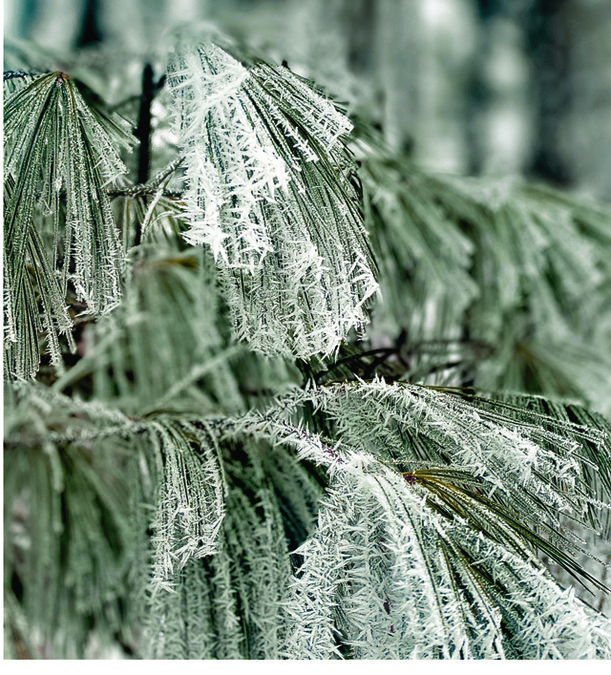MUSCODA - Over the course of the last few days the Driftless region has been treated to a real feast for the eyes. Delicate spikes have coated nearly everything insight. Coupled with heavy fog, many are left feeling as though they stepped into a wintery fairy tale.
Although initially many thought that the beauty was caused by Hoar Frost, but it seems as though it is in fact the lesser known Rime Ice.


Rime Ice forms when supercooled water liquid droplets freeze onto surfaces, leaving behind spiked ice similar to Hoar Frost.
The primary difference between Hoar Frost and Rime ice is that Rime Ice is caused by a freezing fog, and Hoar Frost occurs on clear, freezing nights.
There are three different types of Rime Ice identified by meteorologists. Soft rime which is less dense and is milky and crystalline like sugar. Hard rime, which is somewhat less milky, especially, if it is not heavy. And Clear ice which is transparent and more resembles ice cubes in appearance.
Soft rime is perhaps the most similar to the hoar frost we have been enjoying most recently. Soft rime forms when the water droplets in light freezing frost or mist freezes to the outer surfaces of objects, with calm or light wind. The fog freezes usually to the windward side of tree branches, wires or any other solid objects. Despite their similar appearance Soft rime is formed by vapor first condensing to liquid droplets and then attaching to the surface, whereas hoar frost is formed by direct deposit from water vapor to a solid ice. According to Accuweather.com “Rime is more like an accumulating freezing dew rather than a thick frost,” the website explained. “In extreme cases, rime can build up over a few days and weigh down trees, power lines, and communication towers to the point of causing damage to them.
The other delightful frosty sight many more are familiar with is Hoar Frost.
Hoar Frost, also known as radiation frost or Pruina forms on cold clear nights when conditions are just right. According to Wikipedia, Heat radiates out to the open air faster than it can be replaced from nearby sources, such as wind or warm objects. When these perfect conditions come together, objects cool to below the frost point of the surrounding air, well below the freezing point of water. More simply put, according to accuweather.com, “Hoar Frost is when moisture skips the water droplet stage and appears directly as ice crystals on an object.” They go on to note “hoar frost is much more rare and photogenic than your standard garden variety frost,” Which is perhaps why you felt the urge to “ooh!” and “ahh!” last weekend during its marvelous showing.
Hoar comes from the Old English word meaning “showing signs of old age”- translating for the frost to mean that it makes the trees and bushes look as though they are covered in white hair and have grown old. The name also has different variations depending on where it forms. Air Hoar means it is a deposit of hoar frost on objects above the surface such as branches, plant stems and wires. Surface Hoar refers to the fern-like crystals directly deposited on snow, ice or already frozen surfaces.
Most standard frost may form when the air is dry, however for the rare Hoar Frost to form, the air must be quite unusually moist for winter, while still remaining cold enough.
All of the beautiful frost surrounding us is not only a feast for the eyes from your windows, but also can be taken as an invite from Mother Nature to get out and enjoy this winter wonderland we are blessed with in Wisconsin. Some essential tips for winter hiking include:
•Dress in layers; temperatures can change quickly this time of year. Dressing in multiple different layers make it easy to add or remove clothing and stay comfortable throughout your journey.
•Hike with a partner. Sharing your hike is not only more enjoyable but can also help you if something goes wrong. Even now during the COVID-19 pandemic, there are safe ways to enjoy the great outdoors with a friend, or someone within your Pandemic Pod.
•Be prepared for the worst. Make sure to bring along a map if you’re unfamiliar with where you are hiking, a first aid kit, a charged cell phone or other tools and items you may need for a short or long hike away from home.
•Be aware of the weather forecast. This is especially important on long hikes. Be aware of incoming snow storms or other dangerous weather situations that may arise.
•Start early and know when to turn around, avoid getting caught out in the cold, after dark.
• Have fun and enjoy the view. We are lucky to be surrounded by such beauty in our state and taking time to enjoy it in all seasons is one of the greatest things there is.





